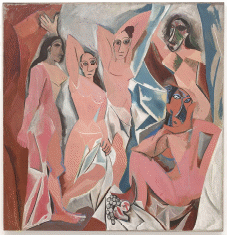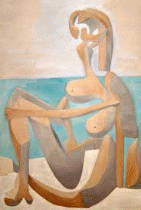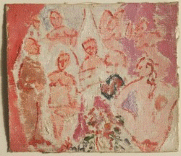If you are looking for an example essay on Pablo Picasso, you are at the right place! Here, you’ll learn more the characteristics of Picasso’s paintings, his biography, and more.
Pablo Picasso: Essay Introduction
Pablo Picasso is one of my most admirable and inspirational artists. Picasso’s accomplishments in art have made him famous throughout the 20th and 21st centuries. The artist was prolific throughout his life. Pablo’s three styles of art include “the Blue, Rose, and African-Influenced Periods” (Sayre 4). Picasso also redefined the aspects of new styles of art such both cubism.
Picasso was born in Malaga on 25 October 1881 (Mallén 2). His birth name was Pablo Diego Paula Trinidad Picasso. His father, Don Jose Blasco, was a famous Spanish painter (Mallén 12). Pablo portrayed some of the best skills as an artist. He was also drawing at a very young age (Franck 11). He was soon preoccupied with painting and art. This affected his performance in school.
Pablo Picasso’s family moved from Malaga to Barcelona in 1895. He was against any kind of formal instruction and soon left school. He painted various landscapes using green and violet tones. He later moved to Paris in 1900. In France, “Picasso began to produce new paintings using different shades of blue and green colors” (Franck 14).
This gave birth to his famous Blue Period. Between 1904 and 1906, Picasso produced another style of art known as the Rose Period. He began to use warm colors to paint his works. In 1909, Picasso co-developed a new style known as Cubism. The style involved the use of neutral and monochrome brownish colors (Mallén 23).
Picasso later moved to Italy and produced new artworks in neoclassical style. As well, Picasso produced sculptures. In 1950, Pablo earned the famous Stalin Peace Prize. This gives Pablo Picasso a great name. He achieved most of his goals as a great artist and died on April 8, 1973 (Mallén 13).
Detailed Description of the Artist’s Work: Medium, Shapes, Sizes, Medium, Colors, and Outstanding Details
The prolific artist used oil on canvas to paint most of his works. He was sensitive about colors because he used them to define his art periods. His austere application and use of color became a unique aspect of his work. His work portrayed doleful subjects such as beggars and prostitutes (Franck 18).
Pablo’s first mistress, Fernande Olivier, influenced most of his works during the Rose Period. Picasso’s Analytic Cubism used neutral and monochrome colors to produce different works. He later developed the famous Synthetic Cubism between 1912 and 1919. Most of the paintings were between 56 x 32 cm and 100 x 80 cm. He used different colors throughout his three art periods.
The artist used paper fragments and newspaper to come up with new works of art. This marked the first application of collage in human fine art. As discussed above, Pablo used different colors throughout his three periods of art. Pablo also used various shapes and subjects to communicate to his audiences.
He used various materials such as oil, canvas, metal bars, and pieces of paper to produce his artworks. Pablo’s invention of cubism and use of collage made his works outstanding (Franck 46). The artist used newspapers and wallpapers for his cubism style. He also made huge sculptors. A good example is “The Maquette”. The cubist monument is 50 meters tall (Richardson, 2007).
Sources of Inspiration and Influence
Some events and nature influenced most of Picasso’s works. For instance, “various African artifacts inspired Pablo’s African-Influenced Period” (Sayre 8). A good example is the painting “Les Demoiselles d’Avignon”. The artist developed new formal ideas and adopted for the Cubism period.

“Les Demoiselles d’Avignon” by Pablo Picasso, 1907
The social decay experienced in Spain explains why Pablo depicted prostitutes and beggars in most of his earlier works. The French “acrobats, circuses, and other events influenced the artist’s Rose Period” (Franck 84).
Picasso’s encounter with Fernande Olivier also influenced his paintings and other works of art (Richardson 37). The artist also wanted to develop his style. He was always willing to experiment and execute new ideas. The artist was keen to examine the issues affecting the people.

“Seated Bather (La Baigneuse)” by Pablo Picasso, 1930, Oil on Canvas (The Museum of Modern Art, New York)
The painting “Seated Bather” portrays Olga Koklova. Pablo married the Russian woman in 1918. In 1930, “Pablo painted the work to portray the woman as a skeletal horror” (Sayre 10). This presents an ironic pose. He sees the woman as empty as the skies. This explains his influences came from his experiences with different people in his life. The artist also used the natural environment to paint different landscapes.
My Personal Reaction to the Artist
Pablo’s “Les Demoiselles d’Avignon” is one of his influential artworks. This explains why Pablo Picasso’s art is very precious and valuable. Many people continue to collect and reproduce the artist’s sculptures and paintings.

“Study for Les Demoiselles d’Avignon” by Pablo Picasso, 1907 (Museum of Modern Art, New York)
I find the artist admirable and respectable because he was a greater painter and sculptor. His choice of color in his artworks is also exemplary. For instance, the Blue Period portrays the artist’s sadness. The Rose Period marked a new beginning in the artist’s career. The artist also used Braque technique to present a new period of art known as Cubism. His styles deviated from the contemporary aspects of fine art.
The style would become a powerful force because many people used it in most of their artworks. Apart from being a great artist, Picasso produced some masterpieces such as “The Guernica to protest against the bombings during the Civil War in Spain” (Richardson 47). As well, the painter was a caring person who used his paintings to address the needs of many people. This makes him my greatest painter.
Works Cited
Franck, Dan. Bohemian Paris: Picasso, Modigliani, Matisse, and the Birth of Modern Art. New York: Grove Press, 2003. Print.
Mallén, Enrique. A Concordance of Pablo Picasso’s Spanish Writings. New York: Edwin Mellen Press, 2009. Print.
Richardson, John. A Life of Picasso: The Triumphant Years, 1917–1932. New York: Albert A. Knopf, 2007. Print.
Sayre, Henry. A World of Art. New York: Pearson, 2012. Print.